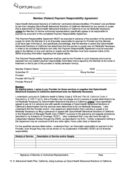Cardiolipin, Conformation, And Respiratory Complex

Content

Three evolutionarily conserved CL-binding pockets have been identified in every available Aac structure solved thus far. Thus, mutant Aac2 constructs engineered to prevent CL binding at each pocket can be used to test whether their occupancy with CL is responsible for its protein-stabilizing and/or conformation-determining effects on Aac2. One approach to experimentally interrogate the hypothesized functional benefits provided by an Aac-RSC assembly would be to establish a series of Aac2 alleles that are defective in specific interactions with either complex III or complex IV even in the presence of CL. These interaction-null Aac2 constructs could then be leveraged to determine whether and how the Aac2-RSC association promotes optimal OXPHOS.
While minor in relative abundance compared to monomers, Aac dimers were additionally identified in several x-ray structures , although their physiological significance has been questioned . A large proportion of the buried surface area between dimers is provided by CL, suggesting that Aac homodimerization, if it does occur, may depend on a CL-based greasy handshake. Last, another layer of complexity into this issue stems from molecular dynamics simulations, which demonstrate that the natural proclivity of Aacs to multimerize is reduced when model membranes lack CL .
cerevisiae parental strain GA74-1A (MATa, his3-11,15, leu2, ura3, trp1, ade8, rho+, and mit+) or GA74-6A (MATα, his3-11,15, leu2, ura3, trp1, ade8, rho+, and mit+). aac2Δ and aac2Δcrd1Δ were generated by replacing the entire open reading frame of AAC2 and CRD1 with markers HIS3MX6 and TRP1, as previously described via polymerase chain reaction –mediated gene replacement . For FLAG- and HA-tagged Aac2, aac2Δ strains of opposite mating type were generated by replacing the entire open reading frame of AAC2 with URA3MX. Each tag sequence (FLAG tag–DYKDDDDK and HA tag–YPYDVPDYA) was added onto the N terminus of the AAC2 open reading frame by overlap extension PCR and cloned into pRS315. Following PCR amplification of the HA- or FLAG-tagged construct, aac2Δ (URA3MX-based) yeast were transformed. Homologous recombinants were selected for by growth in rich dextrose medium containing 0.1% (w/v) 5-fluoroortic acid and positive clones identified by immunoblotting for the appropriate epitope tag. cor1Δ and cox4Δ yeast were generated by replacing the open reading frame of COR1 and COX4, respectively, with HIS3MX6 or TRP1.
Whether this reflects interacting Aac homodimers or, instead, multiple separate Aac monomers is unclear. Third, in yeast, the entire network of Aac2 interactions is dependent on the presence of the mitochondrial-specific phospholipid cardiolipin . CL is made in the IM , has two headgroups and four attached fatty acyl chains, associates with every individual OXPHOS component (5, 8, 9, 25–36), and is critical for the formation and stability of RSCs (37–39), including those reported to contain Aac2 . Nuclear magnetic resonance studies and Aac crystal structures have identified three tightly associated CL molecules per monomer.
Thus, the relationship between CL and Aac oligomerization is likely to be more complex than CL simply acting as a glue holding proteins together. The phospholipid cardiolipin has pleiotropic structural and functional roles that are collectively essential for mitochondrial biology. Yet, the molecular details of how this lipid supports the structure and function of proteins and protein complexes are poorly understood. To address this property of cardiolipin, we use the mitochondrial adenosine 5′-diphosphate/adenosine 5′-triphosphate carrier as a model.

In these conditions, preincubation of crd1Δ mitochondria with CL partially restored Aac2 and RSC assembly in parallel (Fig. 1A and fig. S2A). Furthermore, Aac2 and RSC assembly was not substantially altered by the addition of exogenous CL to WT mitochondria. Thus, endogenous levels of CL are sufficient to support the complete assembly of these complexes.
Three aspects of the reported Aac interactomes are particularly relevant to the controversy surrounding Aac’s oligomeric status. First, the evolutionarily conserved Aac-RSC interaction is notable since the composition of RSCs in yeast and humans is different . Thus, while the molecular details of this interaction likely display species-specific differences, the functional benefit that this association confers would appear to be evolutionarily conserved. Second, endogenously expressed, nonbait Aac isoforms are copurified with yeast Aac2 and the two human Aac isoforms tested . Given the high intraspecies sequence homology of the different Aac isoforms, this indicates that more than one copy of this carrier may be present in Aac-containing complexes.
This could be done in CL-containing mitochondria, thereby circumventing the multitude of mitochondrial functions that are compromised when this lipid is absent. cerevisiae, which lacks complex I, consists of a complex III homodimer attached to one to two complex IVs . To determine whether Aac2 associates with complex III, complex IV, or both complexes, we generated yeast strains that lacked individual subunits that are essential for the assembly of each holoenzyme .
This Section Contains Any Relevant Information That Doesn’t Fit In Any Other Defined Sectionsmore ..miscellaneousi
Next, we constructed diploid strains that coexpressed either WT Aac2 and HA-Aac2 or FLAG-Aac2 and HA-Aac2, in the presence or absence of assembled complex III or IV (Fig. 6D). As suggested by BN-PAGE (Fig. 6A), FLAG-Aac2 copurified complex III subunits when complex IV was missing and complex IV subunits when complex III was absent (Fig. 6E). Intriguingly, HA-Aac2 was copurified with FLAG-Aac2 in the absence of either complex III or complex IV.
As determined by BN-PAGE, neither CATR nor BKA was able to restore the CL-dependent assembly of Aac2 into complexes that likely represent associations with itself and/or heterologous proteins (Fig. 1B, green line at the right of Aac2 immunoblot). Consistent with this interpretation, in CL-lacking mitochondria (Fig. 3A), CATR- or BKA-stabilized FLAG-Aac2 and HA-Aac2 failed to coimmunoprecipitate each other or subunits of either complex III or complex IV (Fig. 3, B and C, and fig. S4). The combined results from the BN-PAGE (Fig. 1) and coimmunoprecipitation experiments (Figs. 2 and 3) indicate that CL promotes the tertiary and quaternary assembly of Aac2 via distinct mechanisms.
In mitochondria lacking Cox4 (cox4Δ), a subunit of complex IV, complex III assembles but complex IV does not (Fig. 6A). Conversely, in mitochondria lacking Cor1 (cor1Δ), a subunit of complex III, complex IV assembles but complex III does not. Aac2 partially comigrated with the complex III dimer in the absence of complex IV (Fig. 6A, red arrowheads) and free complex IV in the absence of complex III (Fig. 6A, blue arrowheads), suggesting that Aac2 can interact with both complexes. In both cases, the putative Aac2-containing complexes were of slightly larger size than the bulk of free complex IV or III dimer detected. CL levels were modestly reduced in the absence of either complex III or complex IV (Fig. 6, B and C).
Oxidative Phosphorylation
Toward this end, hemagglutinin or FLAG tags were knocked into the N terminus of the endogenous AAC2 locus (Fig. 2, A and B). FLAG-Aac2 and HA-Aac2 both supported growth on respiratory media, although HA-Aac2 was slightly impaired relative to WT and FLAG-Aac2 (Fig. 2C). Next, haploid yeast strains with or without the ability to produce CL (crd1Δ) were mated to generate diploid strains that expressed varying combinations of WT Aac2, HA-Aac2, and FLAG-Aac2 at physiologically relevant levels (Fig. 2, D and E). In CL-containing mitochondria, FLAG-Aac2 and HA-Aac2 coimmunoprecipitated each other as well as representative subunits of both complex III and complex IV, to the same extent in the presence and absence of CATR (Fig. 2, F and G, and fig. S3). This indicates that in the presence of CL, Aac2 associates with itself and RSCs in a folded state whose stability is not dependent on CATR. The addition of BKA predigitonin solubilization decreased the amount of HA-Aac2 and complexes III and IV that coimmunoprecipitated with FLAG-Aac2 by 37, 25, and 50% compared to the CATR-stabilized carrier (Fig. 2, F and H).
- First, the evolutionarily conserved Aac-RSC interaction is notable since the composition of RSCs in yeast and humans is different .
- Second, endogenously expressed, nonbait Aac isoforms are copurified with yeast Aac2 and the two human Aac isoforms tested .
- Thus, while the molecular details of this interaction likely display species-specific differences, the functional benefit that this association confers would appear to be evolutionarily conserved.
- Three aspects of the reported Aac interactomes are particularly relevant to the controversy surrounding Aac’s oligomeric status.
Using yeast, we previously demonstrated that the major yeast Aac isoform Aac2 engages in a number of distinct interactions that are dependent on CL. The mechanistic underpinnings of how CL facilitates Aac2 assembly have yet to be resolved. Whether exogenous CL has the same capacity to rescue Aac2 assembly has not been determined. In preliminary experiments, we noted that the efficiency of extracting a range of IM proteins with digitonin varied depending on whether mitochondria contained or lacked CL and was further differentially affected by the addition of exogenous lipids (fig. S1, A and B). Specifically, IM proteins contained in mitochondria lacking CL (crd1Δ) were solubilized at lower concentrations of digitonin than wild type .
Iii D Other Signals
Preincubating mitochondria with phosphatidylcholine reduced the solubilization efficiency of IM proteins in both WT and crd1Δ-derived mitochondria; the addition of bovine CL did not significantly alter the ability of digitonin to extract IM proteins. Furthermore, while the assembly of Aac2 and RSCs was insensitive to the amount of digitonin used for membrane extraction or the inclusion of either PC or CL in WT mitochondria, their assembly was notably affected in crd1Δ-derived mitochondria (fig. S1C).
Yeast devoid of mitochondrial DNA are unable to assemble respiratory complexes III, IV, and V and therefore lack RSCs. As expected, high–molecular weight Aac2-containing complexes, which include Aac2-RSC, were not detected in mitochondria isolated from yeast lacking mtDNA (Fig. 5A). Consistent with a previous report , mitochondrial CL levels were reduced by ~45% in mitochondria from yeast lacking mtDNA compared to their mtDNA-containing parents (Fig. 5, B and C). Since the tertiary assembly of Aac2 (evidenced by smear beneath the major 140-kDa Aac2 monomeric band) was similar or improved in the absence of mtDNA, we conclude that the remaining CL levels are sufficient to support Aac2 assembly (Fig. 5A). The CL-dependent association of Aac2 with RSCs, which is specific as it does not occur in conditions that disrupt both its tertiary and quaternary assembly (Fig. 4), could augment Aac2 transport while benefitting RSC activity. Specifically, the electrogenic exchange of ADPin/ATPout by Aac is positively influenced by the membrane potential (ΔΨ) across the IM , which, of course, is established by the electron transport chain. Similarly, by dissipating the electrical gradient, productive Aac transport makes it easier for RSCs to pump protons.
How does ADP get into the mitochondria?
Mitochondrial ADP/ATP carriers transport ADP into the mitochondrial matrix for ATP synthesis, and ATP out to fuel the cell, by cycling between cytoplasmic-open and matrix-open states. The cytoplasmic side of the carrier is closed by conserved hydrophobic residues, and a salt bridge network, braced by tyrosines.
Here, we have determined that cardiolipin is critical for both the tertiary and quaternary assembly of the major yeast Aac isoform Aac2 as well as its conformation. In addition, we show that multiple copies of Aac2 engage in shared complexes that are largely dependent on the presence of assembled respiratory complexes III and IV or respiratory supercomplexes. Intriguingly, the assembly state of Aac2 is sensitive to its transport-related conformation. Together, these results expand our understanding of the numerous structural roles provided by cardiolipin for mitochondrial membrane proteins.
Cavro® Air Displacement Pipettor (adp)
Hence, we hypothesize that this known functional synergy is further enhanced by being physically associated. Our demonstration that multiple copies of Aac2 can bind separately to complexes III and IV offers the possibility that RSCs can accommodate four or more Aac2 molecules, depending on the stoichiometry of the RSC and whether RSC formation preserves or masks a binding site. Such an arrangement would amplify the postulated functional synergy of the Aac2-RSC interaction. The Aac-specific inhibitors CATR and BKA fix the carrier in distinct conformations that are modeled to allow substrate binding and release on opposite sides of the IM . Furthermore, CATR and CL were demonstrated to have an additive effect in improving the thermostability of Aac2 . In this context and given the importance of CL for Aac2 assembly , we asked whether CATR or BKA could rescue these CL-sensitive Aac2-RSC assembly defects (Fig. 1B). Aac2 assembly was not altered when mitochondria were preincubated in the absence of these inhibitors at either pH 6.0 or 7.4 before detergent solubilization.

Clones were selected on synthetic dropout medium [0.17% (w/v) yeast nitrogen base, 0.5% (w/v) ammonium sulfate, 0.2% (w/v) dropout mix synthetic-his or trp, and 2% (w/v) dextrose] and verified by immunoblot. To generate diploids, strains from GA74-1A and GA74-6A background were transformed with pRS315 and pRS316, respectively, and mated for 3 hours in rich dextrose media containing sterile filtered adenine (0.02 mg/ml). Resulting diploid strains were selected on synthetic dropout media [0.17% (w/v) yeast nitrogen base, 0.5% (w/v) ammonium sulfate, 0.2% (w/v) dropout mix complete, histidine (20 mg/liter), tryptophan (20 mg/liter), and 2% (w/v) dextrose]. Yeast were grown in nutrient-rich YP [1% (w/v) yeast extract and 2% (w/v) tryptone] media that contained 2% (w/v) dextrose (Fig. 1) or 2% (w/v) sucrose (YP-Sucrose; all remaining figures). For growth analysis on solid plates (Fig. 2C), yeast cells were grown in YP-Sucrose before spotting onto YP-Sucrose or YPEG [1% (w/v) yeast extract, 2% (w/v) tryptone, 1% (v/v) ethanol, and 3% (v/v) glycerol] plates [2% (w/v) Bacto agar].
Collectively, these results indicate that Aac2 engages in distinct interactions with subunits of complexes III and IV and that RSCs have the capacity to interact with multiple molecules of Aac2. While FLAG-Aac2 and HA-Aac2 were reciprocally coimmunoprecipitated from CL-containing mitochondria, it is unclear whether this reflects a direct interaction or, instead, the presence of multiple copies of Aac2 in a multiprotein complex. Given that the Aac-RSC interaction is evolutionarily conserved , we asked whether RSCs are required for Aac2 homomultimerization.

While protein thermostability assays and our BN-PAGE analyses (Fig. 1B) establish that CL stabilizes the tertiary structure of Aac2 when extracted with detergents, it is also evident that Aac2 is more or less properly folded in mitochondrial membranes lacking this lipid. This conclusion is based on the ability of protein stabilizing Aac2 inhibitors, when applied to intact CL-lacking mitochondria before detergent extraction, to prevent Aac2 unfolding upon addition of even the mild detergent digitonin. How then does the protein stabilizing activity of CL identified in detergents potentially affect Aac2 function? One possibility is that the extra stability conferred by CL is critical for the proper presentation of binding motifs required for the Aac2-RSC interactions. However, when using these inhibitors, we noted that the ability of CL to promote the tertiary and quaternary assembly of Aac2 are separable attributes, indicating that they most likely reflect distinct CL-Aac2 interactions. The multifaceted manner in which CL promotes Aac assembly as defined in the current study suggests numerous potential mechanisms by which this single lipid can affect ADP/ATP transport that can be experimentally tested.
Unlike mammals, which die in utero when they are unable to produce CL , CL-null yeast are viable and retain limited OXPHOS activity (41, 43–45). Hence, Saccharomyces cerevisiae, a model system commonly used to interrogate lipid-protein interactions , is the best available eukaryotic model to probe CL-dependent protein assemblies in vivo.


